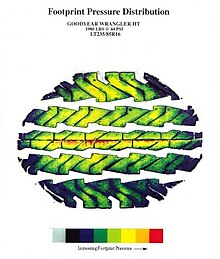Tire contact patch
The tire contact patch or contact patch is the part of the tire that maintains contact with the road .
This is the only place where forces (“grip” or “traction”) can be built up so that the vehicle is guided in a stable manner. In contrast to the car , which has significantly larger and twice as many points of contact, on a motorcycle it is an area barely the size of a palm on the front and rear tires, and on a bicycle it is a finger-sized area. Modern tire technology enables high speeds to be achieved.
The size of the contact patch of a tire depends primarily on the wheel load (e.g. due to the weight of the vehicle) and the tire pressure , because the internal pressure of the tire bears the majority of the wheel load. But the tire width, the tire diameter and the stiffness of the sidewall also play a role.
With the simplified assumption that no part of the wheel load is transferred to the road surface via the tire flanks, the entire wheel load must be distributed and carried by the internal pressure over the contact surface :
This assumption does not apply, in particular, to truck tires. In the case of much thinner-walled bicycle tires, it tends to apply, but not completely.
On a soft surface, the contact area is mainly in the front part of the tire, but is wider there. To minimize the depth of the sinking into the ground, the contact area can be increased by releasing the tire pressure.
Some off-road vehicles have automatic systems that can reduce tire pressure on slippery surfaces to create a larger tire contact area. If the vehicle is stuck in soft sand or the like, it can help to deflate the tires of the drive axle (s), provided that the vehicle is not sitting on the ground due to the reduced ground clearance . In contrast , tire pressure regulating systems are common with armored wheeled vehicles, which are mainly used for military purposes .
Bicycle tires for off-road use have larger contact areas than those for the road, which is achieved through greater width and lower tire pressure. Here, too, the tire pressure is reduced to a minimum on particularly soft surfaces (snow or soft sand).
See also
Individual evidence
- ↑ Truck Tire Types and Road Contact Pressures, by Pedro Yap, June 1989
- ↑ https://www.velomobilforum.de/forum/index.php?threads/reifenlatsch-rein-theoretisch-genau-berechnen.42777/




